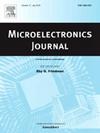An ultra-low-power CMOS image sensor with a new pixel structure in PWM mode featuring a programmable ramp generator for calibration
IF 1.9
3区 工程技术
Q3 ENGINEERING, ELECTRICAL & ELECTRONIC
引用次数: 0
Abstract
This paper presents an ultra-low-power 128 × 128 pixel pulse-width modulation (PWM) CMOS image sensor for low power applications. For always-on ultra-low-power imaging, a novel PWM pixel circuit with a tapered reset technology is implemented. Additionally, by turning off all the pixels except those in reset phase and readout phase, power consumption is reduced from 52 nW to 0.1 nW for each pixel. In addition, to overcome the settling latency of subthreshold comparator, we use a programmable ramp generator for voltage-to-time conversion for linear response, achieving a non-linearity of 0.04%. This ultra-low-power CMOS image sensor is designed and fabricated in CMOS 180 nm process technology. Measurement results demonstrate that the proposed CMOS image sensor consumes only at 62.5 frames per second (fps) with a fill factor of 58% at 0.8V operation. These performances make the image sensor perfectly suitable for IoT applications and some other edge devices.
一种超低功耗CMOS图像传感器,具有PWM模式下的新像素结构,具有可编程斜坡发生器用于校准
本文提出了一种用于低功耗应用的超低功耗128 × 128像素脉宽调制(PWM) CMOS图像传感器。为实现超低功耗成像,设计了一种新颖的带锥形复位技术的PWM像素电路。此外,通过关闭除复位阶段和读出阶段之外的所有像素,每个像素的功耗从52 nW降低到0.1 nW。此外,为了克服亚阈值比较器的沉淀延迟,我们使用可编程斜坡发生器进行线性响应的电压-时间转换,实现了0.04%的非线性。该超低功耗CMOS图像传感器采用CMOS 180纳米工艺设计和制造。测量结果表明,该CMOS图像传感器在工作电压为0.8V时,在62.5帧/秒(fps)下的功耗仅为61.6μW,填充系数为58%。这些性能使图像传感器非常适合物联网应用和其他一些边缘设备。
本文章由计算机程序翻译,如有差异,请以英文原文为准。
求助全文
约1分钟内获得全文
求助全文
来源期刊

Microelectronics Journal
工程技术-工程:电子与电气
CiteScore
4.00
自引率
27.30%
发文量
222
审稿时长
43 days
期刊介绍:
Published since 1969, the Microelectronics Journal is an international forum for the dissemination of research and applications of microelectronic systems, circuits, and emerging technologies. Papers published in the Microelectronics Journal have undergone peer review to ensure originality, relevance, and timeliness. The journal thus provides a worldwide, regular, and comprehensive update on microelectronic circuits and systems.
The Microelectronics Journal invites papers describing significant research and applications in all of the areas listed below. Comprehensive review/survey papers covering recent developments will also be considered. The Microelectronics Journal covers circuits and systems. This topic includes but is not limited to: Analog, digital, mixed, and RF circuits and related design methodologies; Logic, architectural, and system level synthesis; Testing, design for testability, built-in self-test; Area, power, and thermal analysis and design; Mixed-domain simulation and design; Embedded systems; Non-von Neumann computing and related technologies and circuits; Design and test of high complexity systems integration; SoC, NoC, SIP, and NIP design and test; 3-D integration design and analysis; Emerging device technologies and circuits, such as FinFETs, SETs, spintronics, SFQ, MTJ, etc.
Application aspects such as signal and image processing including circuits for cryptography, sensors, and actuators including sensor networks, reliability and quality issues, and economic models are also welcome.
 求助内容:
求助内容: 应助结果提醒方式:
应助结果提醒方式:


